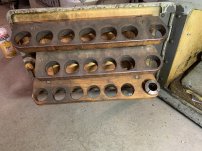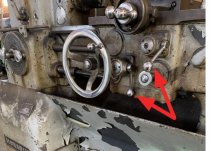Very nice early machine! I especially like all the early features that are in amazingly good condition. By 1940, many of these were eliminated, and in 1941 more were eliminated. These are the ones I noticed:
The feed/thread control dial and handle
The pointer on the cross slide for the compound angle
The domed covers for adjusting the feed clutches
The knob on the apron for selecting fwd feed / threading /rev feed
It also has the early design taper attachment which changed in 1941 to the model that was used for the rest of 10EE production.
And the gearbox has the chrome plated iron knobs and round dial. In 1941 these changed to zinc or aluminum.
And of course, it has the original castings, like the headstock covers and the base with the right hand extension, all of which changed in 1941 when the mg came out.
I think that if you get a copy of the 1939 sales brochure, which is posted on the forum, you will see all those features.
Inside the door in the center of the lathe should be a 5C collet rack, which also was eliminated starting in 1941. That rack came in two or three varieties: most common was the single layer rack which holds a full set graduated by 1/32”. The double rack would hold a full set graduated by 1/64”. I think we have seen one early lathe with a third layer, so it held squares and hexes in addition to 64ths. Pretty amazing.
If it came with any accessories or the optional Monarch tool cabinet, please post some photos. The early clamshell indicators were made from iron, and are quite hard to find.
I think this will be a spectacular machine once it gets cleaned up, so best of luck with it!
 So using single phase power with this set up will not work? Can I leave the VFD in place and use a rotary phase converter? Or should I just replace the VFD with a larger one?
So using single phase power with this set up will not work? Can I leave the VFD in place and use a rotary phase converter? Or should I just replace the VFD with a larger one?

 So using single phase power with this set up will not work? Can I leave the VFD in place and use a rotary phase converter? Or should I just replace the VFD with a larger one?
So using single phase power with this set up will not work? Can I leave the VFD in place and use a rotary phase converter? Or should I just replace the VFD with a larger one?






